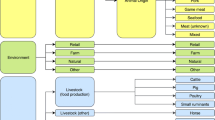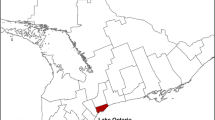Abstract
Background
Temporal clusters of salmonellosis are believed to occur but have not been quantitatively explored, thus, our objectives were to describe trends, seasonal patterns, and clusters of salmonellosis in humans in Alberta by examining isolates reported through passive surveillance systems.
Methods
Cases of salmonellosis reported through Notifiable Disease Records between January 1990 and December 2001 were obtained from Alberta Health and Wellness. Least squares regression was used to characterize the distribution (long-term trends and seasonal patterns) of isolates. A cluster detection test was used to determine if and when isolates of specific serovars aggregated in time, over and above the background distribution. Comparisons were made to temporal patterns in Alberta livestock and to known outbreaks in humans.
Results
S. Typhimurium, Enteritidis, Hadar, Heidelberg, and Thompson were the five most common serovars of the 9,188 isolates reported. The annual number of isolates was relatively stable over time, with a distinct summertime seasonal pattern. Clusters were observed in 23 of 32 serovars examined. More clusters occurred in September and October than in other months, and in 1998 through 2001 than in the early to mid-1990s. Also, more clusters were of short duration than long.
Interpretation
Short-duration clusters likely indicate a point source of infection, while long-duration clusters may indicate exposure to a persistent common source or the occurrence of secondary infections. A sharp increasing trend and a large cluster of S. Heidelberg may have public health implications. Surveillance activities focussed on similarities between common serovars, trends, and temporal clusters in humans and animals, and studies on factors associated with autumn clusters may be useful in preventing outbreaks in humans.
Résumé
Contexte
On estime qu’il se forme des grappes temporelles de cas de salmonellose qui n’ont pas encore fait l’objet d’études quantitatives. Aussi, notre étude visait à dégager les tendances, les schémas saisonniers et les grappes de la salmonellose chez les habitants de l’Alberta en examinant les isolats détectés par des systèmes de surveillance passive.
Méthodes
Après en avoir fait la demande, on a obtenu auprès du ministère de la santé et du mieux-être (Ministry of Health and Wellness) de l’Alberta les cas de salmonellose signalés et inscrits dans les documents relatifs aux maladies à déclaration obligatoire pour la période allant de janvier 1990 à décembre 2001. On a utilisé la technique de régression des carrés pour caractériser la distribution des isolats (de même que les tendances à long terme et les schémas saisonniers). Un test de détection des grappes a permis de déterminer la présence éventuelle d’isolats des sérovars particuliers agrégés et le moment de leur agrégation, indépendamment de la distribution naturelle. L’analyse comparative a visé les schémas temporels du bétail albertain et les flambées connues chez les humains.
Résultats
S. Typhimurium, Enteritidis, Hadar, Heidelberg et Thompson représentaient les cinq sérovars les plus courants parmi les 9 188 signalés. Le nombre d’isolats signalés était relativement stable au cours des années même si on constatait une tendance distincte au cours de la saison estivale. On a observé la présence de grappes chez 23 des 32 sérovars examinés. On a relevé plus de grappes au cours des mois de septembre et d’octobre qu’au cours des autres mois et entre 1998 et 2001 que durant la période s’échelonnant du début au milieu des années 1990. En outre, davantage de grappes étaient de courte durée.
Interprétation
Les grappes de courte durée indiquent vraisemblablement une source ponctuelle d’infection tandis que celles de longue durée pourraient indiquer une exposition à une source constante et commune ou à la présence d’infections secondaires. Une nette tendance à la hausse et une grappe importante de cas de S. Heidelberg sont susceptibles d’avoir des répercussions sur la santé publique. Les activités de surveillance ont surtout visé les similitudes entre les sérovars, les tendances et les grappes temporelles communes chez les humains et les animaux. La réalisation d’études sur les facteurs rattachés aux grappes durant l’automne pourrait contribuer à prévenir les flambées chez les humains.
Similar content being viewed by others
References
Gomez TM, Motarjemi Y, Miyagawa S, Kaferstein FK, Stohr K. Foodborne salmonellosis. World Health Stat Q 1997;50(1–2):81–89.
Sockett, PN. The economic implications of human Salmonella infection. J Appl Bacteriol 1991;71(4):289–95.
Olsen SJ, Bishop R, Brenner FW, Roels TH, Bean N, Tauxe RV, et al. The changing epidemiology of Salmonella: Trends in serotypes isolated from humans in the United States, 1987–1997. J Infect Dis 2001;183(5):753–61.
St. Louis ME, Morse DL, Potter ME, DeMelfi TM, Guzewich JJ, Tauxe RV, et al. The emergence of grade A eggs as a major source of Salmonella Enteritidis infections. New implications for the control of salmonellosis. JAMA 1988;259(14):2103–7.
Ellis A. National foodborne, Waterborne, and enteric outbreak summary report 1997–1998. Can J Infect Dis 1999;10(3):201–6.
Guerin MT, Martin SW, Darlington GA, Rajic A. A temporal study of Salmonella serovars in animals in Alberta between 1990 and 2001. Can J Vet Res 2005;69(2):88–99.
Sato K, Carpenter TE, Case JT, Walker, RL. Spatial and temporal clustering of Salmonella serotypes isolated from adult diarrheic dairy cattle in California. J Vet Diagn Invest 2001;13(3):206–12.
Ward MP, Carpenter, TE. Techniques for analysis of disease clustering in space and in time in veterinary epidemiology. Prev Vet Med 2000;45(3–4):257–84.
Popoff MY, Le Minor L. Antigenic Formulas of the Salmonell? Serovars, 7th revision. Institut Pasteur, Paris, France, 1997.
Microsoft Corporation. Microsoft Excel 2000. Microsoft Corporation, Redmond, WA, USA, 2001.
StataCorp. Stata Statistical Software: Release 7.0. Stata Corporation, College Station, TX, USA, 2001.
Kulldorff M, Green D, Rand K, Gherman G, Williams G, DeFrancesco D. SaTScan v. 3.0: Software for the spatial and space-time scan statistics. National Cancer Institute, Bethesda, MD, USA, 2002.
Statistics Canada. Population and Dwelling Counts, for Canada, Provinces and Territories, 1991 and 1996 Censuses — 100% Data [Web Page]. 2001. Available on-line at: https://doi.org/www.statcan.ca/english/census96/table1.htm (Accessed February 24, 2004).
Statistics Canada. Canadian Statistics — Population, Provinces and territories [Web Page]. 2004. Available on-line at: https://doi.org/www.statcan.ca/english/Pgdb/demo02.htm (Accessed February 24, 2004). aa]15._Hargrett-Bean NT, Pavia AT, Tauxe RV. Salmonella isolates from humans in the United States, 1984–1986. MMWR Surveill Summ 1988;37(2):25–31.
Itoh Y, Sugita-Konishi Y, Kasuga F, Iwaki M, Hara-Kudo Y, Saito N, et al. Enterohemorrhagi? Escherichia coli O157:H7 present in radish sprouts. Appl Environ Microbiol 1998;64(4):1532–35.
Tauxe, RV. Emerging foodborne diseases: An evolving public health challenge. Emerg Infect Dis 1997;3(4):425–34.
Khakhria R, Woodward D, Johnson WM, Poppe C. Salmonella isolated from humans, animals and other sources in Canada, 1983–92. Epidemiol Infect 1997;119(1):15–23.
Centers for Disease Control and Prevention. Nationa? Salmonella Surveillance System Annual Summary, 2000 [Web Page]. 2002. Available online at: https://doi.org/www.cdc.gov/ncidod/dbmd/phlisdata/salmtab/2000/SalmonellaAnnualSummary2000.pdf (Accessed April 2, 2003).
van Duijkeren E, Wannet WJ, Houwers DJ, van Pelt W. Serotype and phage type distribution of Salmonella strains isolated from humans, Cattle, pigs, and chickens in the Netherlands from 1984 to 2001. J Clin Microbiol 2002;40(11):3980–85.
Health Canada. Canadian Integrated Surveillance Report: Salmonella, Campylobacter, pathogenic E. coli and Shigella, from 1996 to 1999 [Web Page]. 2003. Available on-line at: https://doi.org/www.hcsc.gc.ca/pphb-dgspsp/publicat/ccdr-rmtc/03vol29/29s1/index.html (Accessed June 2, 2003).
Pollari F, Powers C. Canadian Integrated Surveillance Report for 1995 of Salmonella? Campylobacter and Pathogeni? Escherichia coli [Web Page]. 1998. Available on-line at: https://doi.org/www.hcsc.gc.ca/pphb-dgspsp/publicat/ccdr-rmtc/98vol24/24s5/index.html (Accessed April 1, 2003).
Weisse P, Libbey E, Nims L, Gutierrez P, Madrid T, Weber N, et al. Salmonella Heidelberg outbreak at a convention—New Mexico. MMWR Morb Mortal Wkly Rep 1986;35(6):91.
Layton MC, Calliste SG, Gomez TM, Patton C, Brooks S. A mixed foodborne outbreak with Salmonella Heidelberg and Campylobacter jejuni in a nursing home. Infect Control Hosp Epidemiol 1997;18(2):115–21.
Statistics Canada. 23F0001XCB Canada food stats [Web Page]. 2002. Available on-line at: https://doi.org/www.statcan.ca/english/IPS/Data/23F0001XCB.htm (Accessed June 17, 2003).
Honish L, Nguyen Q. Outbreak of Salmonella Enteritidis phage type 913 gastroenteritis associated with mung bean sprouts—Edmonton, 2001. Can Commun Dis Rep 2001;27(18):151–56.
Ahmed R, Soule G, Demczuk WH, Clark C, Khakhria R, Ratnam S, et al. Epidemiologic typing of Salmonella enterica serotype Enteritidis in a Canada-wide outbreak of gastroenteritis due to contaminated cheese. J Clin Microbiol 2000;38(6):2403–6.
Clark C, Cunningham J, Ahmed R, Woodward D, Fonseca K, Isaacs S, et al. Characterization of Salmonella associated with pig ear dog treats in Canada. J Clin Microbiol 2001;39(11):3962–68.
Stratton J, Stefaniw L, Grimsrud K, Werker DH, Ellis A, Ashton E, et al. Outbreak of Salmonella Paratyphi B var Java due to contaminated alfalfa sprouts in Alberta, British Columbia and Saskatchewan. Can Commun Dis Rep 2001;27(16):133–37; discussion 137–38.
Buck P, Grimsrud K, Waters J, Cardinal R, Talbot J, Anand C, et al. 1998 FETP Abstracts — Field Epidemiology Training Program — PPHB — Health Canada — Would you like a little Salmonella with your sandwich? [Web Page]. 1998. Available on-line at: www.hcsc.gc.ca/pphb-dgspsp/fetp-pfei/abs98_e.html#BUCK (Accessed May 27, 2003).
Boase J, Lipsky S, Simani P, Smith S, Skilton C, Greenman S, et al. Outbreak of Salmonella serotype Muenchen infections associated with unpasteurized orange juice—United States and Canada, June 1999. MMWR Morb Mortal Wkly Rep 1999;48(27):582–85.
Buxton J, Fyfe M, King A, Paccagnella A, Campbell K, Ellis A, et al. Outbreak of Salmonella serotype Muenchen infection in the United States and Canada associated with unpasteurized orange juice—the British Columbia experience. Can Commun Dis Rep 1999;25(19):161–64.
Canadian Food Inspection Agency. Health Hazard Alert — Imported Farmer Brand peanuts may contain dangerous bacteria [Web Page]. 2001. Available on-line at: https://doi.org/www.inspection.gc.ca/english/corpaffr/recarapp/2001/20010918e.shtml (Accessed June 13, 2003).
Little C. Eurosurveillance Weekly — Volume 5 — Issue 41 (11/10/2001) — Salmonella Stanley and Salmonella Newport in imported peanuts [Web Page]. 2001a. Available on-line at: https://doi.org/www.eurosurveillance.org/ew/2001/011011.asp (Accessed June 13, 2003).
Little C. Eurosurveillance Weekly — Volume 5 — Issue 43 (25/10/2001) — Salmonella Stanley and Salmonella Newport in imported peanuts — update [Web Page]. 2001b. Available on-line at: https://doi.org/www.eurosurveillance.org/ew/2001/011025.asp (Accessed June 13, 2003).
Author information
Authors and Affiliations
Corresponding author
Rights and permissions
About this article
Cite this article
Guerin, M.T., Martin, S.W. & Darlington, G.A. Temporal Clusters of Salmonella Serovars in Humans in Alberta, 1990–2001. Can J Public Health 96, 390–395 (2005). https://doi.org/10.1007/BF03404039
Received:
Accepted:
Published:
Issue Date:
DOI: https://doi.org/10.1007/BF03404039




